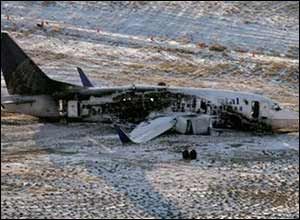By Kristen Wyatt
The Associated Press
 AP Photo The wreckage of a 737 plane sits at Denver International Airport Sunday. The plane skidded off the runway during takeoff Saturday injuring 38 of 110 passengers. |
DENVER — Federal investigators planned to begin examining early Monday the burned carcass of a passenger jet that veered off a runway in Denver and caught fire, while technicans in Washington hoped to recover data from the plane’s two “black boxes.”
The twin-engine Boeing 737-500 was left in a shallow, snow-covered ravine where it came to rest after its aborted take-off Saturday at Denver International Airport.
National Transportation Safety Board officials wanted to make use of scarce daylight hours to examine the wreck, measure skid marks and then conduct their first interviews of the pilots.
Flight data and cockpit voice recorders were recovered and sent for examination to Washington, D.C. It appeared both were in good condition, the NTSB said Sunday.
The accident forced the 115 passengers and crew aboard Continental Airlines’ Flight 1404 to flee through emergency exits as the plane burned.
The jet had shed its left engine and both main landing gears, and caught fire. The entire right side of the jet was burned, and melted plastic from overhead compartments dripped onto the seats.
The plane veered off course about 2,000 feet from the end of the runway and did not appear to have gotten airborne, city aviation manager Kim Day said.
Bill Davis, an assistant Denver fire chief assigned to the airport, said it was a miracle “that everybody survived the impact and the fire.”
The weather was clear but cold when the plane attempted to take off for Houston around 6:20 p.m. Saturday. Winds at the airport were 31 mph, the Federal Aviation Administration said. The runways are elevated so rain and snow will drain away.
“No other aircraft opted against taking off due to wind” before Flight 1404 tried to lift off, FAA spokesman Ian Gregor said.
Davis, one of the firefighters who rushed to the scene, said the plane came to a rest about 200 yards from one of the airport’s four fire stations. Passengers walked out of the ravine in 24-degree cold and crowded inside the station, he said.
A crack encircled much of the fuselage near the trailing edge of the wings, Davis said. There were 110 passengers and five crew members aboard, officials said.
Passenger Gabriel Trejos told KUSA-TV in Denver that the plane buckled toward its middle and that the seats felt like they were closing in on him, his pregnant wife and his 13-month-old son, who was on his lap. His knees were bruised from the seat in front of him.
Another passenger, Maria Trejos, told KUSA that there was an explosion and that the right side of the plane, where they were sitting, became engulfed in flames. The family used an emergency exit and slid down the wing of the jet to the ground.
The injuries included broken bones, but Robert Sumwalt, an NTSB member, didn’t know whether they were caused by the impact or the evacuation.
Many passengers from the flight arrived in Houston, its original destination, on Sunday afternoon, some clearly injured, the Houston Chronicle reported.
The gate where relatives waited at Bush Intercontinental Airport was blocked off from the rest of the terminal. One woman limped off the flight with red-rimmed eyes; another was in a wheelchair, wearing a neck brace, the newspaper reported. A young boy was taken by stretcher straight to an elevator.
Sumwalt, of the NTSB, said the damaged plane would remain for several days in the 40-foot-deep ravine where it landed. That runway will remain closed during the investigation, he said.
Jim Proulx, a Boeing spokesman, said the company was supporting the NTSB investigation. He declined to comment on whether Boeing had any indication of possible problems with the 737-500 jetliner.
“We will also do whatever we can to learn the cause of this accident so that we can prevent a recurrence at Continental or at any other airline,” said Larry Kellner, Continental’s chairman and chief executive officer.
AP Business Writer Daniel Lovering in Pittsburgh and Associated Press writer Colleen Slevin contributed to this report.











